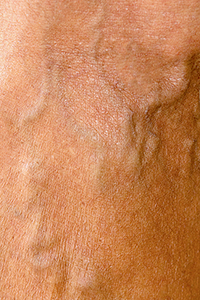Varicose Veins

Varicose veins in the leg of an older woman.
Varicose veins are veins that have become painfully enlarged and can be blue, red or flesh-colored. They are often raised above the skin on legs and look like twisted, bulging cords. Many patients think varicose veins are simply a cosmetic issue, but if left untreated, they can progress to a more serious form of venous disease called Chronic Venous Insufficiency.
Varicose veins occur when the valves in the leg veins no longer function, causing blood to pool in — most often — the legs, although they do have the potential to occur elsewhere.
When the valves in leg veins or elsewhere no longer meet properly, the valves begin to stop working. With this dysfunction in meeting points, the blood within the veins begins to flow backwards, causing enlargement. At this point those veins become varicose.
The most common type of varicose vein is the superficial leg vein which is the product of prolonged standing. Besides the appearance of these veins, they are also very painful when making leg movements, like walking, running, or even standing.
Vein stripping or vein removal are the most common methods to remove the bothersome areas. The Iowa Clinic Vein Therapy Center also offers other less invasive treatments such as laser vein therapy.
Signs and Symptoms of Varicose Veins
- Pain in the legs: fullness, heaviness, aching
- Visible, enlarged veins
- Mild swelling of the ankles
- Skin at the ankle is discolored brown
- Skin ulcers near the ankle